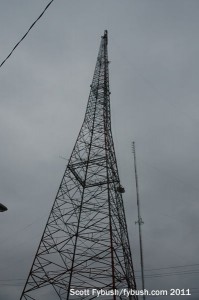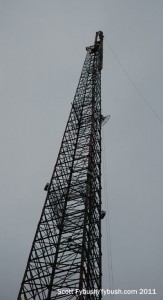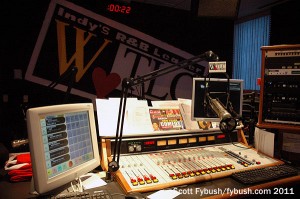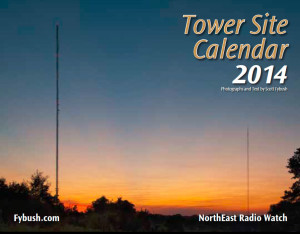NorthEast Radio Watch 12/8/2025: Cichon’s Back in Buffalo
In this week’s issue… Veteran newsman returns - Remembering NY's Leitner, RI's Jones - CT AM saved - Maine AM moves - "Indie" adds suburban signals
Text and photos by SCOTT FYBUSH
It’s a new year here at Site of the Week, and we’ve got some great tower and studio sites to share with you throughout 2014. But before we can dig deeper into the hard drive full of pictures and stories from 2012 and 2013, we’ve got one last installment of our incredibly busy 2011 travels to share with you.
This week’s pictures find us in Indiana in December 2011, visiting some stations in the company of our colleague Blaine Thompson of Indiana RadioWatch – and as always, he gets us into all sorts of interesting places.
This time, for instance, we’re in Muncie, in east central Indiana, on the campus of Ball State University. This is David Letterman’s alma mater, and we are, in fact, in the David Letterman Communication and Media Building, or at least in one of the buildings that connects to that shiny new facility. This is where Ball State’s broadcast outlets are located, and we start down in the ground floor at the biggest of them. WIPB (Channel 49) has been a public station since 1971, when a community group bought what had been a small commercial station, WLBC-TV, and turned it educational.
WIPB was eventually absorbed into Ball State, and today it functions as a secondary PBS outlet, somewhat in the shadow of much bigger WFYI in Indianapolis, an hour or so to the southwest. Its facilities are simple but effective: the master control area runs largely automated, and the main production studio relies heavily on green-screen virtual sets to give WIPB’s local productions a big-market look (and to train students in technology they’ll likely encounter down the road in the commercial world!)


Upstairs in the atrium of the Letterman Building, a big window looks into the studio complex of “Indiana Public Radio,” the regional network based here at WBST (92.1 Muncie) with relay transmitters across east central Indiana. As part of the construction of the Letterman Building in 2007, WBST/IPR ended up with a nice set of studios, including the main air studio shown above at left and the bigger talk/performance studio that looks out into the atrium.
(There’s also a student-run station: “WCRD” has its own studios upstairs in the Letterman Building, and today it’s heard on 91.3 FM over WWHI, formerly a Muncie high school station and recently acquired by Ball State.)
Today, WIPB operates on digital channel 23 from a site south of Muncie – but for most of its analog existence, channel 49 stayed right where it had been as WLBC-TV, on a big self-supporting tower next to the longtime WLBC radio (and former WLBC-TV) studios on E. 29th Street, on the south side of town.
That building is still home to WLBC-FM (104.1) and the former WLBC (1340, now sports WXFN), which use separate towers out back – and so once WIBC was no longer using that self-supporter sitting out there on the front lawn, the radio stations’ owner (then Backyard Broadcasting) decided it was time for the big guy to come down. As you can see from these 2011 pictures, the project was underway when we stopped by – which is why most of the staff had been cleared out of the building and everyone remaining was being allowed in only with hard hats!
This part of Indiana seemed to attract big directional arrays with relatively low power. Muncie’s big top-40 station back in the day was WERK (990), which used six towers off Route 3 south of Muncie to put out just 250 daytime watts. In the hands of owner Bill Poorman and his son, known on-air as Bill Shirk, WERK sounded like a much bigger station for many years – but Shirk eventually moved on to bigger things in Indianapolis, and in the 1990s the six towers came down, the land was sold, and 990 ended up limping along under a series of STAs, probably never to return at full power.
And WERK wasn’t the only station in these parts to push up the towers-to-power ratio. In New Castle, 20 miles or so south of Muncie, the Courier-Times wanted a radio station in the worst way – and you might say it got one. Unable at first to get a spot on the AM dial, the paper became an FM pioneer in 1947 with the debut of WCTW-FM on 102.5. It held on through FM’s dark days but still wanted an AM spot, too, and in 1960, it got a construction permit for WCTW(AM), running 250 watts day and night at 1550 on the dial. Achieving that mighty full-time status required the use of six towers, and up they went on a big piece of land off Route 38 west of town.
The paper eventually sold the stations, which took on the new calls of WMDH/WMDH-FM. And oddly enough, by way of a series of sales to Wilks and then Citadel and then Cumulus, these little stations in this small town off I-70 ended up in the hands of one of the biggest broadcast companies in the country.
(That’s also how the AM side of the operation ended up in 2010 with the calls WLTI: they’d been on a Citadel sister station in Syracuse, New York, and the company needed a place to park them, so they ended up being used once an hour on “WMDH Classic Country” on 1550.)
This is a pretty simple setup out here: a small sales office off the lobby and a hallway running the length of the building, with offices along the front and the studios off the back. WMDH-FM is the big country giant out here, and its studio looks into the AM transmitter room and into a small room that doubles as a newsroom and as an AM studio.
That old Gates AM transmitter failed not long after our 2011 visit, and WLTI was off the air for a few months until it made budgetary sense to Cumulus to procure a replacement. The FM site, not shown here, is north of New Castle off Indiana 3, closer to Muncie; during 2013, the FM was rebranded as “Nash FM,” in the Cumulus way.

Our last stop on this short December day – and indeed, our very last station visit for all of 2011 – was 40 miles or so to the west, down I-70 in downtown Indianapolis.
Just north of Monument Circle, an older office building on East St. Joseph Street has been extensively rehabilitated as the home of Radio One’s Indianapolis cluster: black gospel WTLC (1310), urban WHHH (96.3), top-40 WNOU (100.9 Speedway) and R&B WTLC-FM (106.7 Greenwood).
(There’s even a Bill Shirk connection here: he put 96.3 on the air as a drop-in and sold much of this cluster to Radio One at a very healthy profit; other pieces, including the AM facility and the intellectual property behind WTLC and “Radio Now” WNOU, came over later in spinoffs from Indy-based Emmis Communications.)
The radio studios are all on the first floor of the building, arranged in a sort of a “C” shape along a long hallway. There’s heavy use of acoustical foam here, including some very nifty use of colored foam to create station logos in the wall of the WTLC-FM studio. And because of the formats here, there are more turntables than you’d find in most clusters these days, including an entire studio for live mix shows on WHHH.
And there’s one more surprise here: that C-shaped corridor of studios surrounds a TV studio and control room. When we visited in 2011, this was WDNI-CD (Channel 19), the latest incarnation of the low-power TV station (formerly on analog 53 and then 65) that had been running music videos as “Indy’s Music Channel” for a decade, complete with local hosts who’d tape their shows in this little studio.
In 2013, Radio One signed a deal that ended “Indy’s Music Channel” and put Telemundo programming on channel 19, with a local news operation planned for this space sometime soon.
Thanks to WIPB’s Glenn Shick; Todd Merickel, then of WMDH; and Radio One’s David Hood for the tours!
 The 2014 Tower Site Calendar has been years in the making.
The 2014 Tower Site Calendar has been years in the making.
But the wait is over. The Tower Site Calendar, 2014 edition, is still shipping daily and ready for immediate hanging on your wall.
Need a calendar or two? Place your order today and we’ll send them right off to their loving homes, spiral bound, shrink wrapped and best of all, with a convenient hole for hanging!
This year’s gorgeous electronic pinups include the iconic towers of Catalina Island, a combiner system in St. Louis, the twin towers of KNRS in Salt Lake City, a historic rooftop site in Jamestown, New York and many more!
Click here to order your new calendar!
Then check out our store page for our other great merchandise, including the last-ever FM Atlas, the new NRC AM Log and a model of the KSAN tower.
And don’t miss a big batch of Muncie IDs next Wednesday, over at our sister site, TopHour.com!
Next week: Los Angeles, April 2012
In this week’s issue… Veteran newsman returns - Remembering NY's Leitner, RI's Jones - CT AM saved - Maine AM moves - "Indie" adds suburban signals
In this week’s issue… Scripps stations face takeover - Sinclair moves more affiliations - CT stations sold - Maine AM surrendered - Remembering WVBR's Shapiro, WABC's Morgan
In this week’s issue… CT TV legend succumbs to cancer - Remembering PA's Adams - FCC still stalled by shutdown - Pittsburgh morning host exits
In this week’s issue… FCC faces reopening challenges - Veteran Boston anchor retires - Morning shift in Toronto - NYC FMs expand reach